Stun Gun vs. Taser: Which One is Right for You?
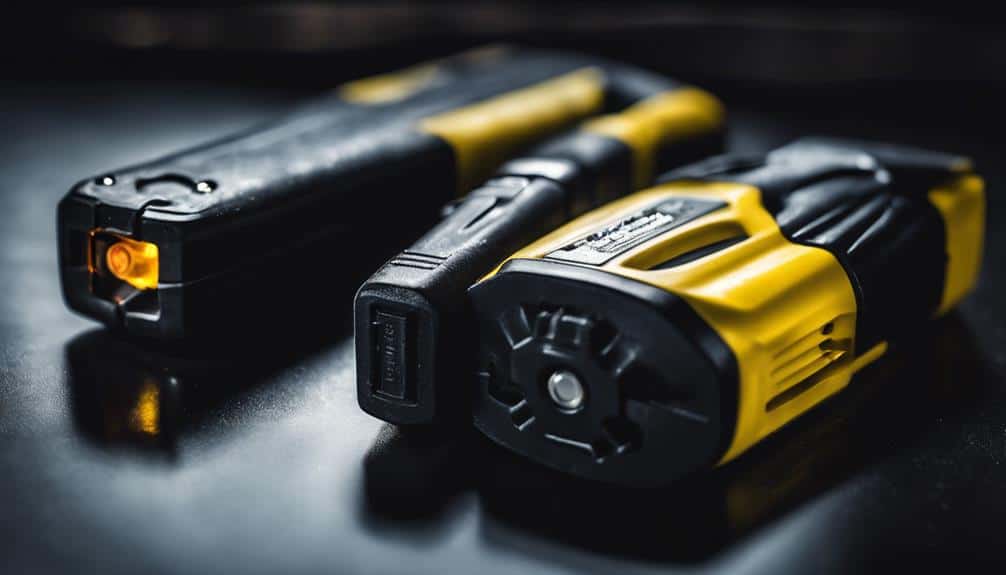
Choosing between a Taser and a stun gun? Here’s the scoop: Tasers shoot probes connected by wires up to 15-35 feet, offering a “long-distance relationship” with your attacker. They zap muscles, causing involuntary spasms and incapacitation. Stun guns, however, need you to get up close and personal, delivering a shock on direct contact. While stun guns are often easier to buy due to fewer legal restrictions, Tasers provide a safer distance for defense. Both have perks, like portability and peace of mind, but consider which makes you feel safer and fits your comfort level. Curious to find out which suits you best?
What Is a Taser?
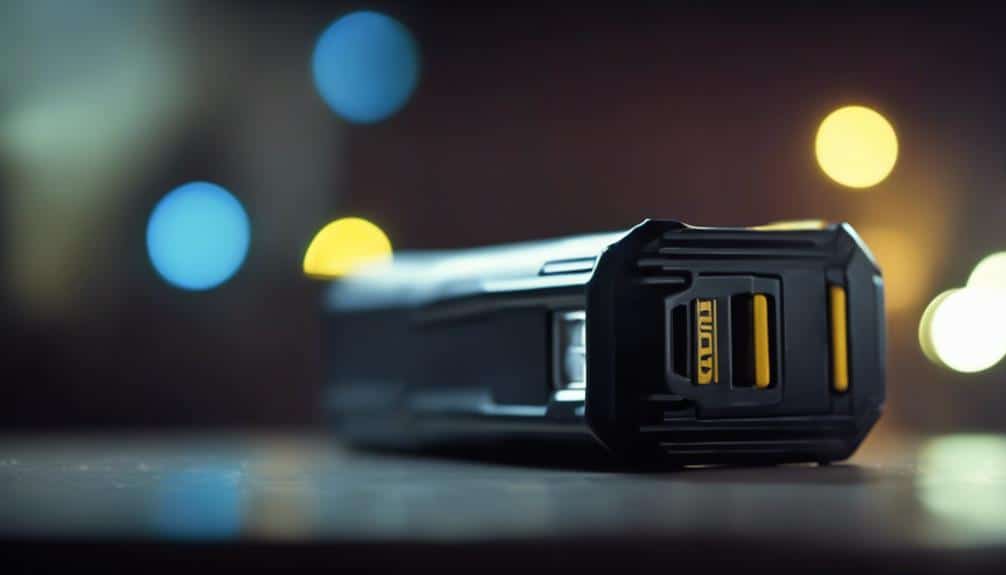
A Taser is a brand of electroshock weapon designed to incapacitate a person by delivering electric shocks from a distance. You might be surprised to learn that the Taser has quite a history. It was invented in the 1970s by Jack Cover, a NASA researcher who wanted to create a non-lethal weapon for law enforcement. The name ‘Taser’ comes from a fictional device in a children’s book called ‘Tom Swift and His Electric Rifle.’
Over the years, Taser models have evolved considerably. The early versions were fairly basic, but modern Tasers are high-tech gadgets with multiple features. For example, Taser X26 and Taser X2 are popular models that police departments use. These models come with advanced targeting systems and safety mechanisms to make them more effective and safer to use.
The Taser Pulse is another interesting model designed specifically for civilian use. It’s smaller, lighter, and easier to carry, making it a popular choice for personal self-defense.
How a Taser Works
So, how does a Taser actually work?
When you fire a Taser, it launches two small probes that deliver an electrical pulse, hitting targets up to 15 feet away.
This pulse causes neuromuscular incapacitation, which is just a fancy way of saying it temporarily freezes your muscles, making it hard to move.
Electrical Pulse Mechanism
Through a series of rapid electrical pulses, a Taser incapacitates a target by disrupting their voluntary muscle control. Firing a Taser releases an electric discharge, creating a temporary but intense energy transfer. This process sends signals that override the brain’s control over muscles, causing temporary paralysis. It’s like turning off a switch with a bit more zap.
Imagine you’re trying to run a marathon, and suddenly, every muscle in your body decides it’s time for a dance party. That’s basically what happens to the target. The electrical pulses force the muscles to contract uncontrollably, leaving the person unable to move effectively. It’s like being caught in a sudden storm of muscle spasms.
The Taser’s magic lies in its ability to deliver these electrical pulses through two small probes attached to wires. Once those probes contact, they complete the circuit, allowing the electric discharge to flow into the target. The result? A temporary, non-lethal immobilization that gives you or law enforcement enough time to take control of the situation.
Firing Distance Range
When using a Taser, you’ll find that its effective firing distance typically ranges between 15 to 35 feet, depending on the model. This distance gives you a bit of a buffer, allowing you to stay at a safer range from a potential threat. Now, don’t imagine yourself in a Wild West shootout; remember, Tasers aren’t designed for long-range engagements.
The key to a Taser’s functionality lies in its projectile travel. When you pull the trigger, the Taser fires two small probes connected to the device by thin wires. These probes can travel through the air and hit the target within the specified distance. However, there are a range of limitations. If you’re too far away, the probes mightn’t reach your target effectively, reducing the Taser’s effectiveness.
On the flip side, getting too close can also be problematic. The wires need enough space to spread out and contact the target. So, consider it a sweet spot: not too far or close. Understanding this range helps you use the Taser accurately and effectively, ensuring you can protect yourself when necessary. So, aim wisely and stay within that golden range!
Neuromuscular Incapacitation Effects
Understanding the firing distance range is essential, but it’s equally important to grasp how a Taser’s neuromuscular incapacitation effects work to stop a threat effectively.
When you fire a Taser, it sends two small probes connected by wires to the device. These probes deliver electrical pulses that disrupt the communication between the brain and the muscles. This interruption causes muscle contractions and involuntary movements, making it nearly impossible for the target to control their body.
Imagine trying to dance to your favorite song but suddenly finding yourself doing the robot uncontrollably. That’s what happens when someone gets tased—except it’s not nearly as fun! The pulses override the body’s normal electrical signals, forcing muscles to contract rapidly and intensely. This effect is what makes a Taser so effective at incapacitating a person. They can’t move, let alone continue any threatening actions.
It’s fascinating how a simple electric pulse can take down a grown person, right?
Taser Advantages

One of the main advantages of a Taser is its ability to incapacitate an attacker from a distance, providing you with a safer defensive option. Imagine you’re in a tense situation; with a Taser, you don’t have to get up close and personal. Instead, its portable design allows you to carry it conveniently, much like your smartphone. Law enforcement officers, in particular, benefit from this feature, as it enables them to maintain a safe distance while still effectively managing threats.
Now, let’s talk about ease of use. Tasers are designed to be user-friendly. You won’t need a degree in rocket science to figure it out. Just aim, fire, and let the device do its job. The bright, flashy light and the electric crackle often serve as a deterrent, potentially stopping an attacker before things escalate.
And, hey, Tasers aren’t just about defense but also about peace of mind. Knowing you’ve got a reliable tool to protect yourself can be incredibly empowering.
Taser Limitations
While Tasers can be pretty handy, they do have some drawbacks you should know about.
For one, their effectiveness is limited by range—so if your target is too far, you might be out of luck.
Plus, there’s always the risk of misfires, which can make for an awkward story later.
Limited Range Effectiveness
A Taser’s effectiveness is limited by its range, typically requiring you to be within 15 to 35 feet of the target. This means you must be fairly close, which can be nerve-wracking if you’re dealing with a potentially dangerous situation.
Now, let’s talk about battery life. Your Taser’s battery must be in top shape to work effectively. If the battery’s low, you might be in a sticky situation with an uncooperative device.
Weather conditions also play a significant role. Rain, snow, or heavy wind can impact a Taser’s performance. Imagine trying to hit a target in a downpour—it’s not ideal. These elements can affect the accuracy and distance the probes can travel, potentially rendering the Taser useless when you need it most.
Higher Risk Misfires
In addition to weather and battery concerns, Tasers also suffer a higher risk of misfires. Imagine you’re in a high-stakes situation, and your Taser decides to strike—talk about bad timing! Misfires can happen due to various factors affecting the device’s reliability.
Sometimes, the probes don’t deploy correctly, or the wires get tangled. Either way, it’s a major hiccup.
Manufacturers have been working on misfire prevention techniques to improve device reliability. They tweak the design and run extensive tests, but no device is foolproof. Even the best Tasers can malfunction occasionally, leaving you in a sticky situation.
It’s like having a car that refuses to start when you’re running late—frustrating, right?
What Is a Stun Gun?
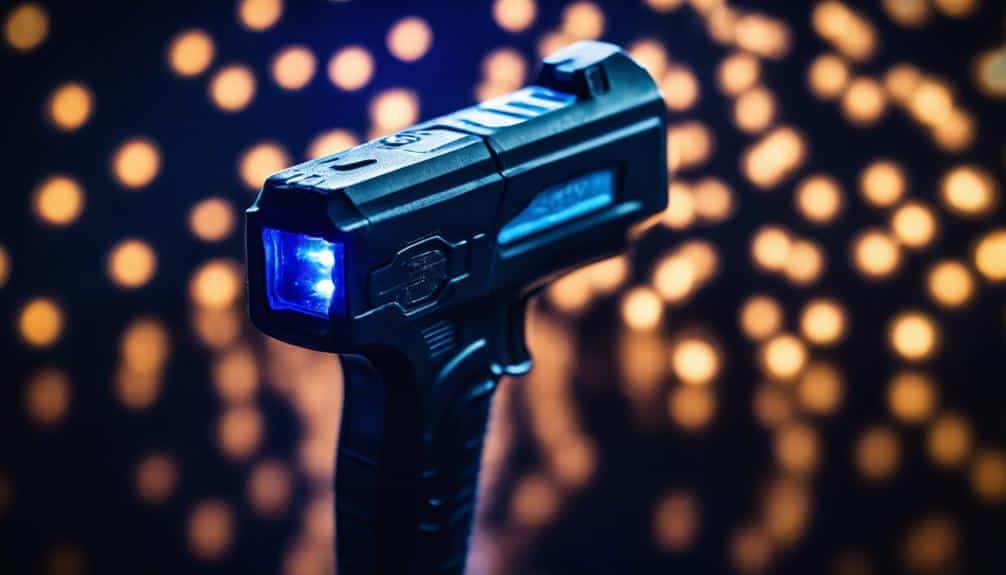
Ever wondered how a stun gun actually works? At its core, a stun gun is a handheld device that delivers an electric shock to incapacitate an attacker temporarily. Unlike Tasers, stun guns require direct contact with the target. When you press it against someone’s body and activate it, the electrical shock disrupts their muscle functions, leaving them disoriented and unable to move effectively.
However, you should be mindful of the legal implications before carrying one. In some areas, owning or using a stun gun can be restricted or even illegal. It’s important to check your local laws to avoid any unpleasant surprises. The last thing you want is to get into trouble with the law while trying to stay safe.
Another thing to take into account is the battery life. Stun guns are powered by batteries, and their effectiveness depends on how well-maintained those batteries are. Regularly check and charge your stun gun to ensure it’s ready when needed. You don’t want to be caught in a sticky situation with a dead battery, right? So, keep it charged and stay aware of its power levels.
Understanding these basics can help you decide whether a stun gun is right for you.
How a Stun Gun Works
To understand how a stun gun works, you need to know about electric shocks and muscle disruption. Think of your muscles as a tightly coordinated dance team. A stun gun interrupts that dance, making the muscles contract quickly and uncontrollably.
A stun gun gets its power from a battery. This battery sends an electric current through two metal prongs. When you press these prongs against an attacker, the current travels through their skin, causing intense pain and temporary paralysis. It’s like hitting a pause button on their aggressive behavior.
Now, let’s talk about safety features. Stun guns have safety mechanisms to prevent accidental discharge. You’ll often find a safety switch that you must flip before using the device. Some models even have LED lights to show when the device is ready.
Using a stun gun takes some practice, but it’s pretty easy. You don’t need to be an expert, just quick and confident. The goal is to give yourself enough time to escape a dangerous situation. Stay safe and stay smart!
Stun Gun Advantages
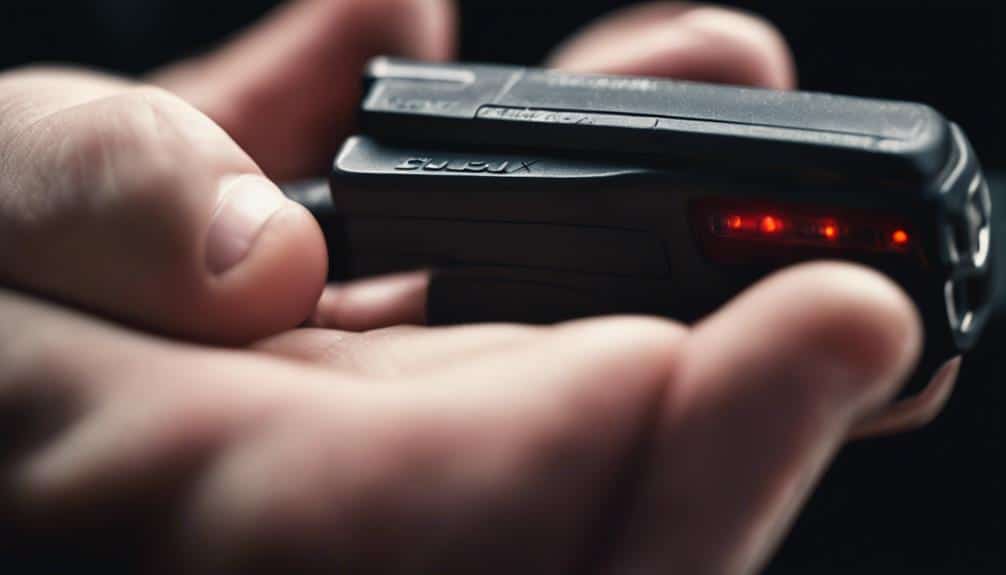
When you’re looking for a self-defense tool, a stun gun has some great perks.
It’s small and light, making it easy to carry around, and it provides immediate protection when you need it most.
Plus, you can feel safe knowing it uses non-lethal force to incapacitate an attacker.
Easy to Carry
Stun guns are small and light, making them easy to carry for personal protection. You don’t want to haul something heavy when you’re just trying to stay safe, right? That’s where stun guns’ small size and lightweight come in handy. They’re small enough to fit in your purse or even your pocket, so you can always have one nearby without feeling weighed down.
Imagine you’re out for a jog and want to carry something for protection. A stun gun’s light weight won’t slow you down. You can easily slip it into your running shorts or arm pouch. Plus, their small size means they’re discreet. You won’t look like you’re preparing for a mission, just a regular day.
Stun guns come in different shapes and sizes, looking like everyday items like flashlights or cell phones. This makes them even easier to carry around without drawing unnecessary attention. Plus, their easy-to-use design means you won’t need a manual to figure them out. You’ll feel more confident knowing you have a reliable, easy-to-carry tool for personal safety.
Immediate Self-defense
A stun gun helps you defend yourself right away by stopping an attacker in seconds. If you find yourself in danger, a stun gun can give a strong electric shock that messes up the attacker’s muscles. This gives you time to get away.
When considering whether a stun gun is right for you, think about these factors:
- Legal Considerations: Before you decide, check your local laws. Some places have strict regulations or outright bans on stun guns. Knowing what’s legal in your area is important to avoid any unintended trouble.
- Personal Preferences: Stun guns come in various shapes and sizes, from flashlight models to disguised versions like cell phones. Find one that fits comfortably in your hand and suits your lifestyle. Whether you want something sleek and compact or a bit more robust, there’s a model for you.
- Ease of Use: Stun guns are generally straightforward to operate. Most have a simple on-off switch and a trigger button. Practice using it safely to be confident if you ever need it.
Non-lethal Force
Stun guns offer a big advantage for self-defense because they can stop an attacker without causing lasting harm. Imagine you’re in danger and need to act fast. A stun gun gives a strong electric shock that stops the attacker’s muscles from working, letting you get away. The best part? It’s not deadly, so you don’t have to worry about causing serious injuries.
Stun guns usually have fewer legal restrictions than guns. Many places let you carry one without a permit, making them easier to get for personal safety. But remember to check your local laws to ensure you follow the rules.
People generally think well of stun guns. They see them as responsible tools for self-defense, and like that, they protect without using deadly force. This positive opinion makes it easier to carry a stun gun without causing alarm.
Stun Gun Limitations
Stun guns can be useful for personal defense, but they have some important limitations. They’re not perfect, so keep these points in mind:
First, the battery life can be a big issue. Stun guns need batteries to work, and if the battery is dead, the stun gun won’t work. Make sure to check and maintain the batteries regularly. If you don’t, you might end up with a useless gadget when you need it the most.
Second, weather conditions can affect how well a stun gun works. Rain, snow, or extreme cold can mess with its performance. Imagine trying to defend yourself in heavy rain and finding out your stun gun isn’t working properly. That’s not good, right?
Lastly, you need to be close to your attacker to use a stun gun. Unlike a Taser, which works from a distance, a stun gun requires you to make contact with the attacker. This can be risky and might put you in danger.
Here’s a quick summary:
- Battery Life: Needs regular checking and maintenance.
- Weather Conditions: Can affect functionality.
- Proximity: Requires close contact with the attacker.
Taser Vs Stun Gun: Key Differences
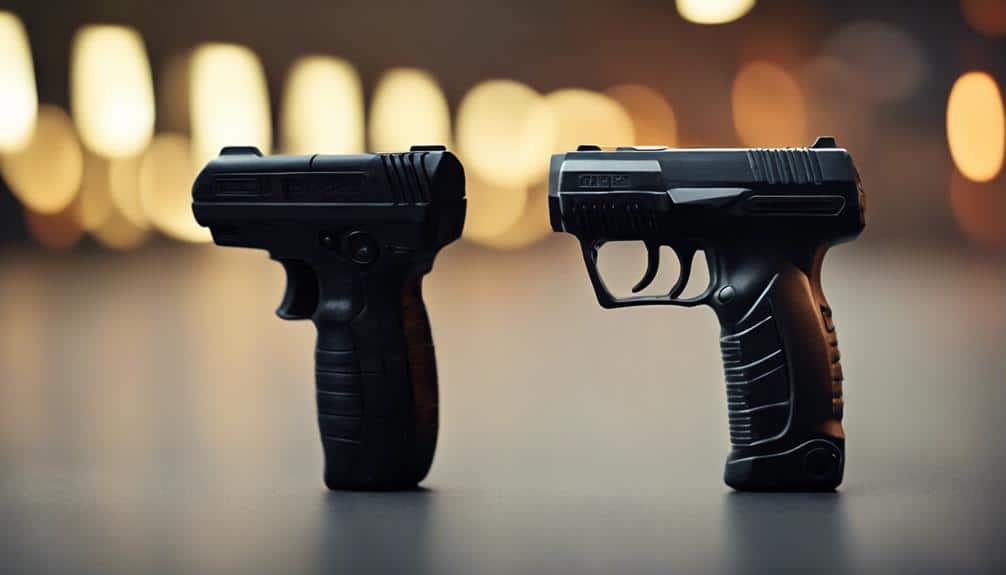
How do tasers and stun guns differ when it comes to personal defense?
Let’s dive right in. First off, the design differences between a Taser and a stun gun are pretty big. A taser can shoot out two small probes attached to wires, letting you stop an attacker from up to 15 feet away. In contrast, a stun gun needs direct contact with the attacker to work. So, a Taser might be better for you if you prefer keeping your distance.
Now, let’s discuss legal rules. Not all states in the U.S. treat tasers and stun guns the same. Some places have stricter rules for tasers, requiring permits or even banning them. On the other hand, stun guns usually have fewer legal issues, making them easier to obtain for most people.
Choosing the Right Device
When picking a self-defense device, consider your comfort level, the laws, and the situations you might encounter. A Taser and a stun gun each have their own benefits, but your personal preferences will help you decide.
Comfort and Ease of Use:
Think about how comfortable you feel using each device. A Taser allows you to maintain distance from an attacker, whereas a stun gun requires close contact. A Taser might be the better choice if you’re not keen on getting up close and personal.
Legal Constraints:
Check your local laws. Some places have strict regulations on both Tasers and stun guns. Knowing what’s legal in your area is important to avoid unwanted legal troubles.
Budget Considerations:
Tasers can be more expensive than stun guns. If budget is a concern, a stun gun might be the more economical option. However, weigh the cost against the features and benefits you’re getting.
Ultimately, the best device for you will depend on what you’re comfortable with, what’s legal, and what fits your budget. Remember, the goal is to feel safe and confident, whether you opt for a Taser or a stun gun.
